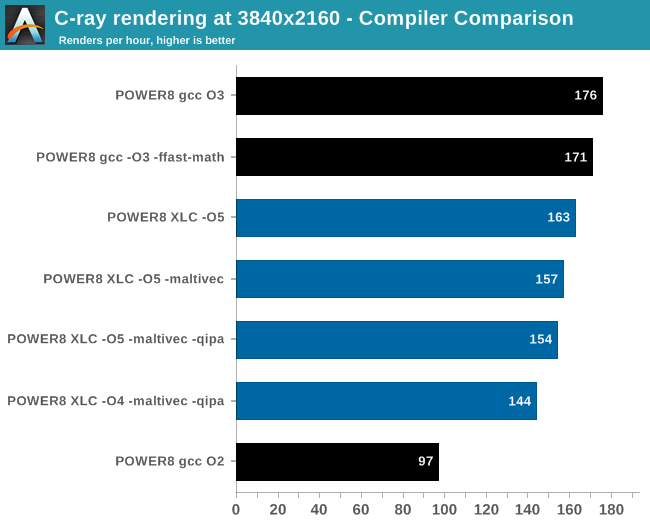The IBM POWER8 Review: Challenging the Intel Xeon
by Johan De Gelas on November 6, 2015 8:00 AM EST- Posted in
- IT Computing
- CPUs
- Enterprise
- Enterprise CPUs
- IBM
- POWER
- POWER8
Floating Point & Compilers
When looking at floating point performance we also tried out different compiler settings.

But nothing we tried gave us better results than GCC with the "-O3" setting. It looks like that setting is very effective as it almost doubles performance compared to "-O2". Once again, the XLC compiler fails to deliver any speed boost. In fact, XLC compiled code is slower than GCC 4.9.










146 Comments
View All Comments
LemmingOverlord - Friday, November 6, 2015 - link
Mate... Bite your tongue! Johan is THE man when it comes to Datacenter-class hardware. Obviously he doesn't get the same exposure as teh personal technology guys, but he is definitely one of the best reviewers out there (inside and outside AT).joegee - Friday, November 6, 2015 - link
He's been doing class A work since Ace's Hardware (maybe before, I found him on Ace's though.) He is a cut above the rest.nismotigerwvu - Friday, November 6, 2015 - link
Johan,I think you had a typo on the first sentence of the 3rd paragraph on page 1.
"After seeing the reader interestin POWER8 in that previous article..."
Nice read overall and if I hadn't just had my morning cup of coffee I would have missed it too.
Ryan Smith - Friday, November 6, 2015 - link
Good catch. Thanks!Essence_of_War - Friday, November 6, 2015 - link
That performance per watt, it is REALLY hard to keep up with the Xeons there!III-V - Friday, November 6, 2015 - link
IBM's L1 data cache has a 3-cycle access time, and is twice as large (64KB) as Intel's, and I think I remember it accounting for something like half the power consumption of the core.Essence_of_War - Friday, November 6, 2015 - link
Whoa, neat bit of trivia!JohanAnandtech - Saturday, November 7, 2015 - link
Interesting. Got a link/doc to back that up? I have not found such detailed architectural info.Henriok - Friday, November 6, 2015 - link
Very nice to see tests of non-x86 hardware. It's interesting too se a test of the S822L when IBM just launched two even more price competitive machines, designed and built by Wistron and Tyan, as pure OpenPOWER machines: the S812LC and S822LC. These can't run AIX, and are substantially cheaper than the IBM designed machines. They might lack some features, but they would probably fit nicely in this test. And they are sporting the single chip 12 core version of the POWER8 processor (with cores disabled).DanNeely - Friday, November 6, 2015 - link
"The server is powered by two redundant high quality Emerson 1400W PSUs."The sticker on the PSU is only 80+ (no color). Unless the hotswap support comes with a substantial penalty (if so why); this design looks to be well behind the state of the art. With data centers often being power/hvac limited these days, using a relatively low efficiency PSU in an otherwise very high end system seems bizarre to me.